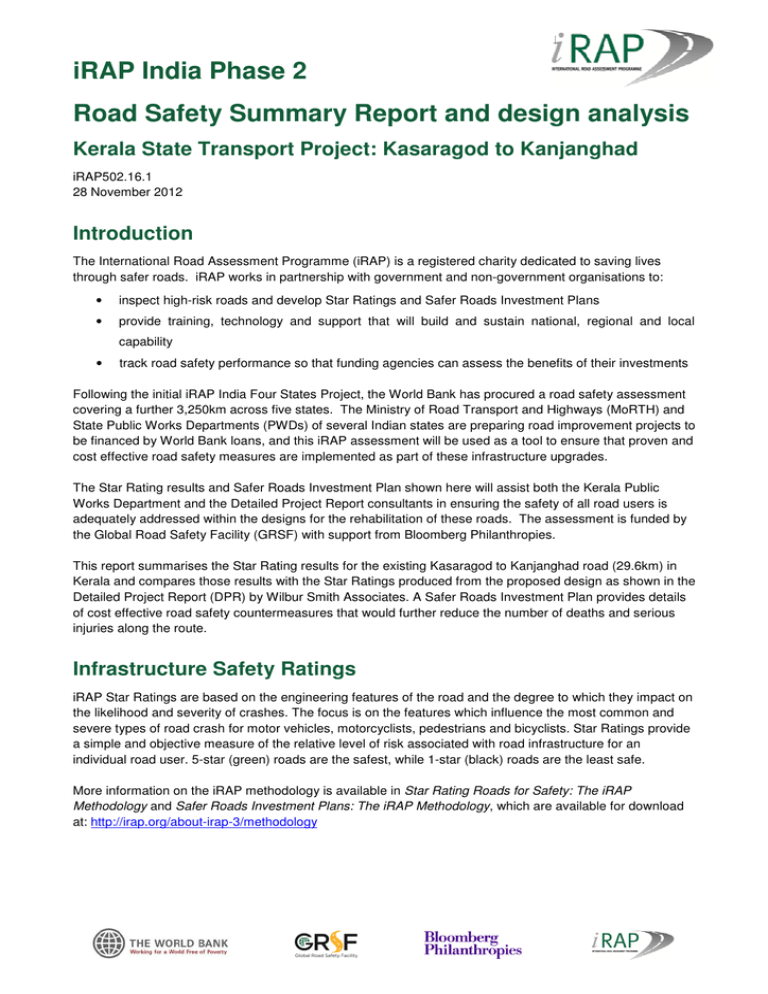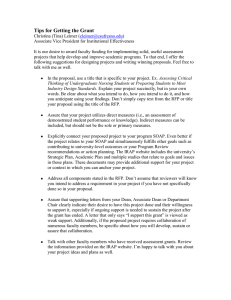iRAP India Phase 2 Road Safety Summary Phase 2 Summary
advertisement

India2 KSTP KK Rd | 1 iRAP India Phase 2 Road Safety Summary Report and design analysis Kerala State Transport Project: Kasaragod to Kanjanghad iRAP502.16.1 28 November 2012 Introduction The International Road Assessment Programme (iRAP) is a registered charity dedicated to saving lives through safer roads. iRAP works in partnership with government and non-government non government organisations to: • inspect high-risk risk roads and develop Star Ratings and Safer Roads Investment Plans • provide training, technology and support that will build and sustain national, regional and local capability • track road safety performance so that funding agencies can assess the benefits of their investments Following the initial iRAP India Four States Project, the t World Bank has procured a road safety s assessment covering a further 3,250km across five states. states The Ministry of Road Transport and Highways (MoRTH) (Mo and State Public Works Departments (PWDs) of several Indian states are preparing road improvement projects to be financed by World Bank loans, and this iRAP assessment essment will be used as a tool to ensure that proven and cost effective road safety measures are implemented as part of these infrastructure upgrades. upg The Star Rating results and Safer Roads Investment Plan shown here will assist both the Kerala Public Works Department and the Detailed Project Report consultants in ensuring the safety of all road users is adequately addressed within the designs for the rehabilitation of these roads. The assessment is funded by the Global Road Safety Facility (GRSF) with support from Bloomberg Philanthropies. This report summarises the Star Rating ating results for the existing Kasaragod to Kanjanghad road (29.6km) in Kerala and compares those results with the Star Ratings produced from the proposed design as shown in the Detailed Project Report (DPR) by Wilbur Smith Associates. Associates A Safer Roads Investment Plan provides details of cost effective road safety countermeasures countermeasures that would further reduce the number of deaths and serious injuries along the route. Infrastructure Safety Ratings iRAP Star Ratings are based on the engineering features of the road and the degree to which they impact on the likelihood and severity off crashes. crashes. The focus is on the features which influence the most common and severe types of road crash for motor vehicles, motorcyclists, pedestrians and bicyclists. Star Ratings provide a simple and objective measure of the relative level of risk associated associated with road infrastructure for an individual road user. 5-star star (green) roads are the safest, safest while 1-star star (black) roads are the least safe. safe More information on the iRAP methodology is available in Star Rating Roads for Safety: The iRAP Methodology and Safer afer Roads Investment Plans: The iRAP Methodology, Methodology which are re available for download at: http://irap.org/about-irap-3/methodology 3/methodology India2 KSTP KK Rd | 2 Kasaragod to Kanjanghad Star Ratings (29.6km) Vehicle occupants Star Rating Baseline Design 0% 2% 3% 48% 56% 21% 14% 24% 27% 5% 0% 0% Baseline Design 0% 0% 1% 24% 40% 44% 20% 28% 39% 5% 0% 0% Baseline Design 1% 1% 0% 0% 0% 5% 1% 24% 98% 71% 0% 0% Baseline Design 0% 0% 0% 0% 1% 24% 28% 46% 71% 30% 0% 0% Motorcyclists Star Rating Pedestrians Star Rating Bicyclists Star Rating A comparison of the Star Rating tables for the th baseline results and the e proposed design show that the percentage of high-risk (1- or 2-star) star) sections has reduced from 41% to 29% % for vehicle occupants. High-risk High road sections for motorcyclists have reduced from 59% to 33%. India2 KSTP KK Rd | 3 High-risk risk sections for pedestrians have seen a reduction from 99% to 95% with the he highest risk (1-star) (1 sections reducing from 98% to 71%. High-risk High risk sections for bicyclists have dropped from 99% to 76% with 11 star sections seeing a reduction from 71% to 30%. Road Attributes The following table summarises the road attributes recorded along the corridor at both the time of the baseline survey (May 2012) and those that have been recorded to reflect the proposed design. It allows for a direct comparison of the amended road features and helps to illustrate lustrate the relationship between road infrastructure attributes and road user risk. The existing road attributes were recorded using video data collected by Indian Road Survey and Management (IRSM) in May 2012 and coded by IRSM staff according to the iRAP P Coding Manual: V3 Edition. The design attributes were coded by engineers from Wilbur Smith Associates, Bangalore in Oct.2012. The iRAP Star Rating Quality Assurance Guide was followed to ensure the highest standards of quality and consistency during the e road coding process and subsequent quality reviews. Road attribute summary (survey urvey length: 29.6km) 2 Road attribute Category Baseline Design Traffic flow aadt 10,000 to 15,000 10,000 to 15,000 40km/h or less 0% 0% 50km/h 0% 0% 60km/h 100% 100% 70km/h 0% 0% 80km/h 0% 0% one 88% 88% two 13% 13% wide 62% 100% medium 28% 0% narrow 10% 0% wide 5% 0% medium 2% 100% narrow 8% 0% none 85% 0% straight 81% 75% moderate 17% 25% sharp 1% 0% very sharp 0% 0% adequate 0% 25% poor 20% 0% not applicable 80% 75% adequate 20% 100% poor 80% 0% present 0% 0% not present 100% 100% good 28% 100% medium 26% 0% poor 45% 0% safety barrier 0% 0% Operating speed (see next section on the importance of operating speed in relation to the iRAP model) Number of lanes (per direction) Lane width Paved shoulder width Curvature Quality of curve Delineation Shoulder rumble strips (raised profile edge lines) Road surface condition Median type India2 KSTP KK Rd | 4 Road attribute Category Baseline Design physical 1-5m 13% 13% physical <1m 1% 0% centre line 86% 88% safety barrier 1% 8% steep fill slope 1% 1% object 0-1m 1% 0% object 1-5m 85% 80% object 5-10m 12% 11% object >10m 0% 0% safety barrier 1% 6% steep fill slope 3% 3% object 0-1m 13% 6% object 1-5m 70% 70% object 5-10m 13% 14% object >10m 0% 1% merge lane 0 0 roundabout 3 1 signalised 0 11 turn lanes 0 21 median crossing 11 11 rail crossing 0 0 others 59 70 adequate 6 92 poor 67 11 none 97% 68% adj. to traffic 2% 30% physical barrier 1% 2% signalised 0 0 unsignalised 34 48 present 1% 1% not present 99% 99% present 11% 11% not present 89% 89% Traffic calming not present 100% 100% Bicycle lane not present 100% 100% Motorcycle lane not present 100% 100% Roadside severity (left) Roadside severity (right) Intersections Intersection quality Sidewalk provision Pedestrian crossing facilities Pedestrian fencing Street lighting The Importance of Operating Speeds The risk of death and serious injury is highly dependent upon the speed at which the traffic is travelling along a given road. iRAP policy determines that risk assessments are undertaken based on either the mandatory th speed limit of a particular road section on or the 85 percentile operating speed of the vehicles, whichever is higher. In the absence of a clearly defined speed limit along the route and the lack of formal speed survey data, these Star Rating results have been produced based on estimated operating operating speeds of 60km/h based on data collected during the survey. For more information regarding vehicle speeds and the th iRAP protocols see: http://irap.org/about-irap-3/research 3/research-and-technical-papers India2 KSTP KK Rd | 5 Economic Assessment Using actual crash data where available, an estimate of the number of deaths and serious injuries that occur on the surveyed network is made. Crash C modification factors are then used to provide an estimate of the number of road deaths and serious injuries that are likely to be prevented through the infrastructure improvements that are proposed. It is important to ensure that improvements such as lane widening, resurfacing, additional lanes and paved shoulders do not result in excessive vehicle speeds, particularly where vulnerable road users such as pedestrians and bicyclists are present. In such cases vehicle speeds must be effectively managed in order to minimise risk. Assuming that the proposed design does not lead lead to an increase in vehicle operating speeds, it is estimated that the he new road design is likely to reduce the number of fatal and serious injuries (KSIs) by 39%, preventing 66 deaths and serious injuries each year and over 1,300 deaths and serious injuries es over the next 20 years. Deaths and serious injuries prevented Kasaragod to Kanjanghad Estimated road deaths per year Existing Proposed design 16 10 Estimated road deaths prevented per year Estimated KSIs per year 6 66 Estimated KSIs prevented per year Estimated KSIs over 20yrs 105 171 2,100 3,420 Estimated KSIs prevented over 20yrs 1,320 Reduction 39% Not only do road deaths and serious injuries cause emotional pain and distress, they also have a huge economic impact on individual families (who may have lost a vital source of income) and society as a whole. Current estimates put the cost of road crashes crashes at around 3% of global GDP, therefore it stands to reason that well targeted road safety plans can realise large returns on investment. It is estimated that the economic benefits of a reduction in the numbers of deaths and serious injuries from 171 to 105 per year, as seen in this study, would total approximately US $2.1 $ million per year in crash costs saved. Safer Roads Investment Plans Plan Whilst the proposed design is expected to prevent an estimated 1,320 deaths and serious injuries over the next 20 0 years, analysis shows that it may m be cost effective to include additional road safety countermeasures with the potential to prevent a further 930 deaths and serious injuries. The Safer Roads Investment Plan (SRIP) shows a list of affordable and economically economically sound road safety treatments, specifically tailored to further reduce risk on this section of road, with the list providing suggestions on how the designs may be improved i in terms of road safety. The comparison of the recorded road attributes used used in both the baseline and the design analysis shows that the proposed project upgrade has a strong maintenance and capacity improvement focus whilst safe road infrastructure could still be improved, particularly for vulnerable road users. Each countermeasure proposed in the SRIP is supported by strong evidence that, if implemented, it will prevent deaths and serious injuries in a cost-effective cost way,, i.e. it is suggested that the treatments on the list will save more money in crash costs prevented prevented than it costs to construct and maintain the feature. India2 KSTP KK Rd | 6 Nevertheless, each countermeasure on the list should be regarded as a recommendation only for further investigation and must be subject to additional prioritisation, concept planning and detailed design before implementation. Although the results below were generated using a BCR threshold of 1, this can be increased in order to produce a smaller, less costly programme of works to suit budget constraints. List of recommended countermeasures based bas on the SRIP for the proposed design Countermeasure Length / sites KSI saved (20 years) BCR Traffic calming 26.8 km 197 4.5 Signalise intersection (3-leg) 63 sites 146 2.0 Pedestrian fencing 7.7 km 98 57.1 Street lighting (intersection) 79 sites 96 1.4 Central hatching 23.1 km 85 18.1 Unsignalised pedestrian crossing 114 sites 66 1.2 Parking improvements 10.2 km 60 3.4 Street lighting (mid-block) 12.6 km 56 1.2 Motorcycle lane (painted on carriageway) 29.6 km 53 3.6 Footpath provision 20.0 km 50 2.2 Signalised pedestrian crossing 20 sites 23 1.6 930 2.6 Total KSI = people killed and seriously injured BCR = benefit cost ratio Full details of each recommended countermeasure, countermeasur including geo-reference data, location maps map and strip plans showing the location by distance of up to five recommended recom countermeasures for each road section, are available within ViDA, the iRAP online software at http://vida.irap.org/. Descriptions of these countermeasures, countermeasures and d many other road safety treatments, including advice on implementation issues and crash reduction effectiveness can be found at the Road Safety Toolkit http://toolkit.irap.org . © International Road Assessment Programme (iRAP) 2012 201 This report was prepared by Luke Rogers,, using iRAPv3. iRAPv3 iRAP technology including protocols, processes and brands may not be altered or used in any way without the express written agreement of iRAP. iRAP is registered in England & Wales under company number 05476000. Registered Charity Number: 1140357 Registered Office: 60 Trafalgar Square, London, WC2N 5DS.



